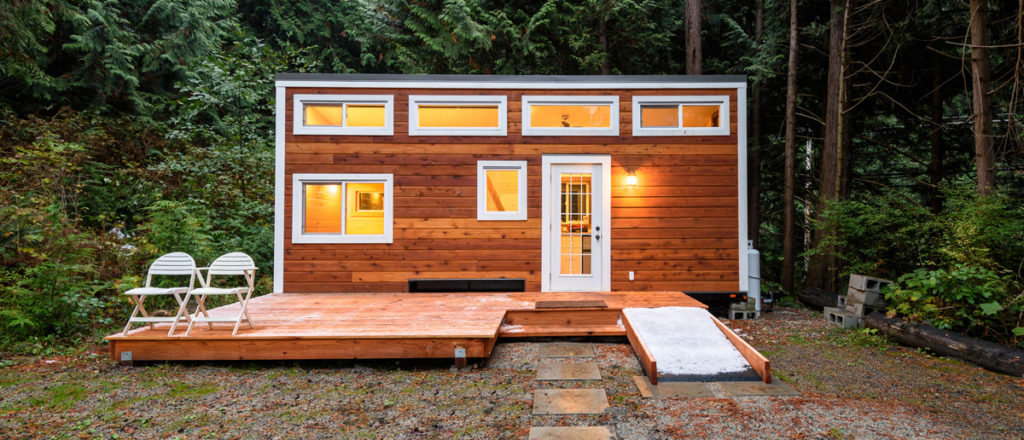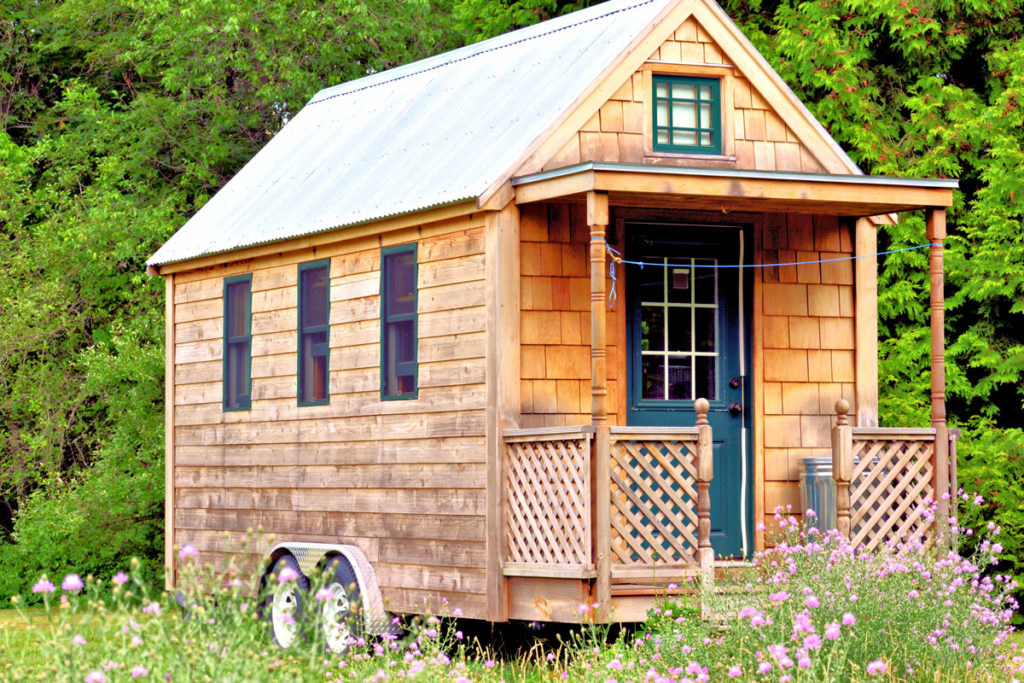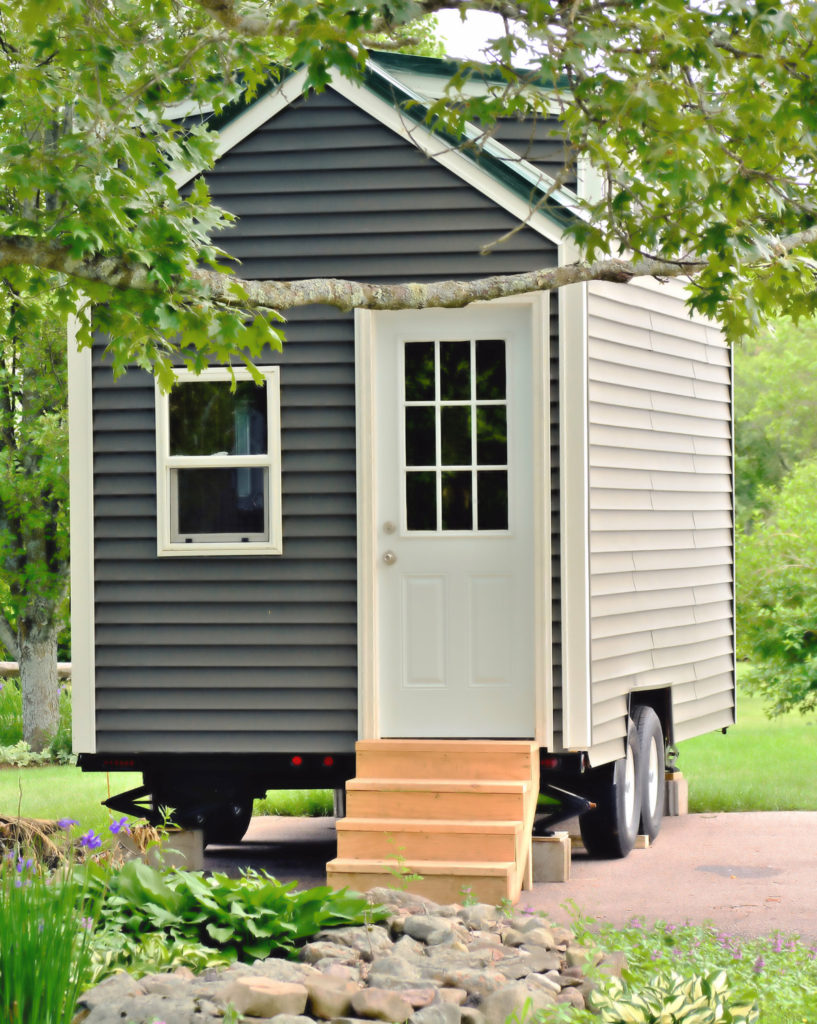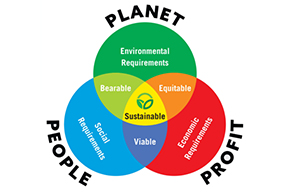
Tiny homes are growing in popularity, thanks to tv shows like “Tiny House, Big Living,” “Tiny House Builders,” and even “Extreme Homes.” While the US Census currently does not track tiny homes, it is estimated that tiny home sales accounted for 1% of 2012 real estate sales, and that new sales range from 2,000 to 5,000 units per year (iProperty Management, 2020). Given the growing awareness of and interest in tiny homes, along with the rising prices of single-family homes, it is important that local jurisdictions consider whether there may be a need or desire for tiny homes in their community, where tiny homes can be located, design requirements, and procedures for approval of tiny homes.
Defining Tiny Homes and Villages
Defining the terms “tiny home” and “dwelling” is crucial to establishing how and where tiny homes are permitted. Tiny homes are hard to define because of the variety of characteristics they may have:
- Located on rented or owned property
- Various shapes and sizes (100-500 square feet is typical)
- Made from virgin or recycled materials, including shipping containers and pods
- Constructed on-site by certified builders, or assembled on-site with prefabricated or modular components, or created from do-it-yourself kits
- On wheels or on a permanent foundation
- Range in complexity from simple to elaborate and may include multiple levels
- Connected to municipal utilities or self-sufficient and “off-grid”
The 2018 International Residential Code provides a somewhat broad definition of a tiny home: “a site built dwelling that is 400 square feet or less in floor area excluding lofts” (International Code Council, 2018). However, even the term “dwelling” can vary between states and local jurisdictions. Housing that may be similar to tiny houses may already be defined in a local zoning code; these include: detached dwelling units on permanent foundations, houses mounted on a chassis, efficiency apartments, small dwellings built on-site or prefabricated in factories, and those not meeting the HUD standards for manufactured homes and/or the Recreational Vehicle Industry Association’s standards for a park model recreational vehicle (American Planning Association, 2021). Using these basic definitions, a community can tailor its definitions to suit an identified need, such as small, stationary affordable homes for older adults arranged in a group setting. Alternatively (or additionally), small homes on wheels may suit people who have a need or desire to live in more than one location due to work, family responsibilities or lifestyle.
Benefits of Tiny Homes
Tiny homes are attractive to people seeking to simplify, own their own home, live closer to nature and/or live in a community with like-minded people. Tiny homes can serve a community in many ways, including:

- Smaller household sizes. In the US, household sizes are decreasing as the population ages and birth rates stay low; existing housing options for a small household of one to two people may be too big, on too much property or too expensive. Tiny homes provide an additional option to better accommodate smaller families or single individuals.
- Housing costs. The cost of home ownership is rising, both for existing and new homes. Tiny houses, with their smaller footprints, cost less than traditional housing and offer new opportunities for home ownership that can help build individual wealth.
- Utility costs. Utilities, whether connected to the grid or not, are more cost-efficient in tiny homes.
- Sprawl. Tiny homes may provide an alternative option to sprawl by infilling small areas.
- Workforce housing. Workforce housing is a growing need, particularly for young professionals. Tiny homes can be located near employment centers and businesses, serving as part of a community revitalization strategy.
- Older residents. Tiny homes offer manageable spaces and affordable housing for older residents, freeing up local housing stock for families and attracting new residents. In addition, these homes can offer independent but close living for elderly relatives when allowed as an accessory dwelling unit, serving as an alternative to the rising cost of residential care.
- Sustainability. Due to their compact nature, tiny homes may allow communities and individuals to reduce greenhouse gas emissions and meet sustainability goals.
- Vulnerable populations. Housing for those currently homeless is challenging in many communities. Tiny homes may fill this need by providing transitional housing, often by providing a communal bathroom and kitchen space and individual sleeping quarters.
- Flexibility. Tiny homes offer flexible living locations – from a single home in the woods to multiple homes in a community.
Challenges of Tiny Homes
The variety of tiny house types and the lack of a specific definition of “tiny house” in many jurisdictions causes a range of legal questions and issues yet to be resolved. Currently, many jurisdictions do not have land-use and development regulations that allow for tiny homes.

- Construction/Building Codes. Construction and building codes seem to be more challenging for tiny house owners than zoning codes, as many of the standard requirements for traditional homes are difficult to include in the design of a tiny house.
- Zoning Codes. Zoning requirements, such as off-street parking requirements and restrictions against parking recreational vehicles as well as prohibitions on using recreational vehicles as habitation outside of designated parks make it difficult for tiny house owners to find a place to put their house.
- Other concerns. Despite the benefits there may be concerns regarding tiny homes. Some of these include:
- Concentrated, dense developments of tiny homes could lead to strain on infrastructure. This can be avoided based on sound forecasts of capacity of the local systems.
- Many communities find typical “NIMBY” arguments being raised, often based on stereotypes and perceptions of renters or those with lower incomes. Education and communication will be important to address these concerns.
- Allowing tiny homes in community settings may take up land that could be used for larger homes for bigger households (families). However, more housing units would likely give families more options, especially as empty nesters move out of their larger homes.
- Small units could increase local rental rates, but this argument is in opposition to economic theories of supply and demand and is also less likely.
Conclusion
Tiny homes have the potential to meet the housing needs of various groups of people, including some vulnerable populations. They can also provide benefits to the community through revitalization as an alternative to infill development and workforce housing, reduced greenhouse gas emissions, and increasing affordable housing options. However, thoughtful work is needed at the local level to ensure tiny homes can be safely and successfully integrated into the community.
Other Resources and Examples:
- Local example of a tiny home village: Tiny Homes Detroit/Cass Community Housing
- Local example of a zoning ordinance supporting tiny homes: Briley Township, Michigan
- Knoxville, TN clearly outlines planning standards for tiny homes – Construction Guidelines
- Golden, CO has a helpful fact sheet on the difference between RV, manufactured home, and traditional home types, and where tiny homes fall on the matrix. It also has a short FAQ about how to have a tiny home in Golden.
- Washington State has created a certification for DIY RVs, which could make do-it-yourself tiny house on wheels (THOWs) possible and a very clear step-by-step packet of how to legally have a tiny home.
- The Greater Bemidji Area of Minnesota updated its zoning code to allow for the PUD approach for tiny home land subdivisions (Sec. 1101.F).
References
American Planning Association. (2021). Tiny houses and micro-apartments. Tiny Houses and Micro-Apartments (planning.org)
Butler, S. (2015, December 30). Tiny homes: Coming to a neighborhood near you? MRSC Insight Blog. MRSC – Tiny Homes: Coming to a Neighborhood Near You? MRSC – Ti
Butler, S. (2017, January 24). Tiny houses as a workable option to house the homeless. MRSC Insight Blog. MRSC – Tiny Houses as a Workable Option to House the Homeless
Elliot, D.L. & Sullivan, P. (2015). Tiny houses, and the not-so-tiny questions they raise. Zoning Practice, 32(11).
Iglesias, T. (2014). The promises and pitfalls of micro-housing. Zoning and Planning Law Report, 37(10).
International Code Council. (2017). 2018 International residential code for one- and two-family dwellings, 1st edition. International Codes Council.
iProperty Management. (2020). Tiny house statistics. Tiny House Statistics [2021]: Market Size & Industry Growth (ipropertymanagement.com)
Linning, S. (2021, March 31). Care pods are the new granny annexe! Covid drives interest in stylish self-contained garden cabins for elderly relatives to live close by – and you DON’T always need planning permission. Mailonline. Why care pods are the new granny annexe! | Daily Mail Online
Nelson, A. (2016, June 27). Legalizing the tiny house: Bringing rogue housing in from the cold. Sightline Institute. Legalizing the Tiny House – Sightline Institute
Turner, C. (2017). It takes a village: Designing “tiny house” villages as transitional housing campgrounds. University of Michigan Journal of Law Reform, 50, 931.
A Checklist of Zoning Considerations for Tiny Houses
Given the increase in popularity of tiny homes, local jurisdictions should consider how they may or may not accommodate them in their communities. The following checklist can be used to guide the integration of tiny homes into any community.
- Determine the reason(s) your community is considering tiny homes and what you hope to gain by allowing them. This may offer insights into whether to permit tiny homes on wheels or not as well as if utility connections should be required.
- Compare tiny houses with existing housing types allowed in the community, such as accessory dwelling units, efficiency units, studio apartments, single room occupancy units, and mobile homes. Determine if tiny houses need to have their own separate definition, or if they can be grouped with another housing type that already exists. See the definitions matrix by Golden, CO in the additional resources as a starting guide.
- Determine areas where tiny homes are compatible with existing uses and decide if they will be permitted by right or as a special use in each of the areas.
- Consider local residential standards for what makes homes “habitable”
- Consider allowable density of areas with tiny homes with respect to available infrastructure.
- Update/create regulations about matching the exterior characteristics of other homes and buildings in the area. Because certain characteristics may increase the cost of tiny homes, prioritize what is most important.
- If tiny homes are intended to provide more affordable housing options, consider transportation networks and if areas near bus lines and daily amenities could be tiny-house friendly.
- If tiny homes are intended to assist the sandwich generation in caring for both their children and their parents, allowing tiny homes as accessory dwelling units in residential areas may make sense. Characteristics that are required for consideration as an accessory dwelling unit should also be considered, including:
- Occupancy limits for unrelated individuals
- Stipulations about where the owner resides: Does the owner have to occupy either the primary housing unit OR the ADU?
- Consideration for the entrance door of the tiny home in relation to the street
- Consider the location of community amenities, goods and services that attract and serve older residents and if those areas could be suitable for tiny homes.
- Define the planning standards for tiny homes, specifically:
- Minimum sq. ft. per living unit
- Height, bulk, and setback standards
- Lot coverage
- Parking
- Landscaping and screening requirements
- Permissible kinds of construction (i.e. traditional, prefabricated, modular, etc.)
- Determine the degree to which the community is willing to accommodate tiny houses that do not meet current building codes or federal manufactured home standards if they can be made safe for long-term occupancy in other ways
- If the homes are intended for individuals with low-incomes or other qualifying characteristics, determine the application process for selecting tenants/owners
- Consider whether the community is interested in co-housing (private homes with shared resources/amenities). Review, and revise if needed, existing procedures for land subdivision, as well as standards for cohousing development.
- Revise design review procedures and standards to reflect any decisions made regarding tiny homes
- Share resources and processes for putting tiny houses in your community
Giffels Webster has been dedicated to making communities better for over 65 years, specializing in community planning, civil engineering, landscape architecture, Geographic Information Systems, traffic engineering, and surveying.
For more information, please call Giffels Webster at 866.271.9663 and visit www.giffelswebster.com.



